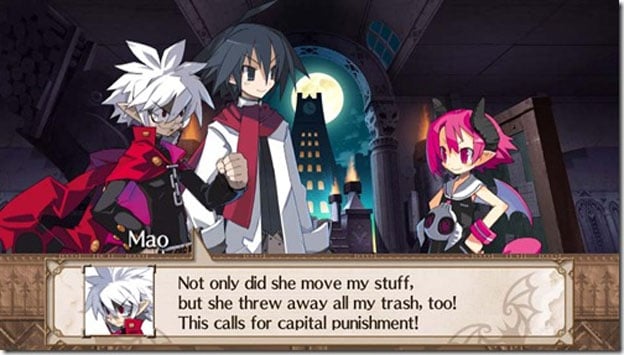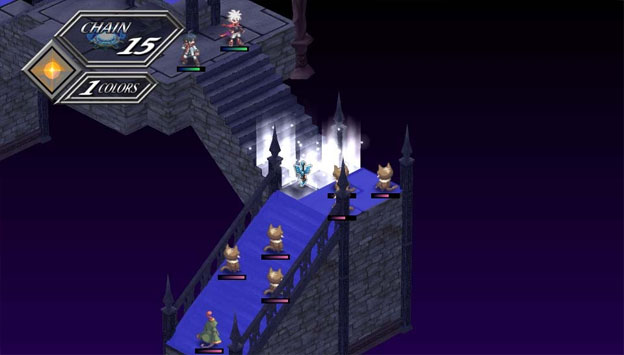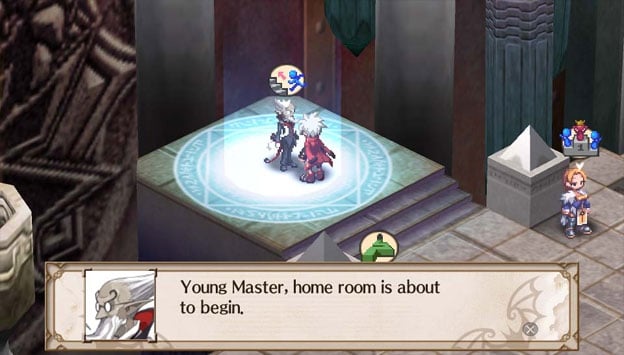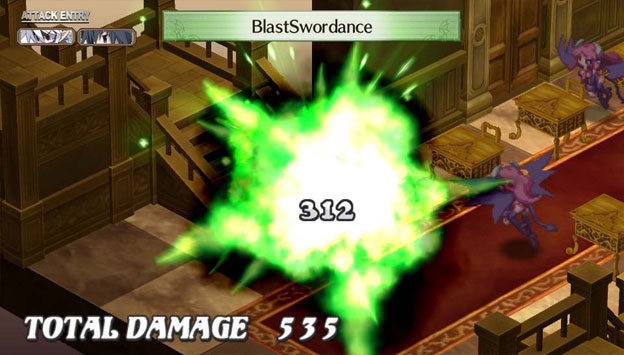The Sad Death Of Save Data
As much as I love my PlayStation Vita, it’s hard to ignore one particular gaping hole in its software lineup so far: It lacks the type of game that will keep you playing for hundreds of hours. It’s a shame, because the Vita’s portable nature makes it a great platform for the sort of strategy games and RPGs that can be played in short bursts, yet have lengthy campaigns and deep subsystems that add up to massive gameplay experiences. Thankfully, Disgaea 3: Absence of Detention is here to finally fill that gap.
Absence of Detention is a port of the PS3’s Disgaea 3: Absence of Justice, which was notorious for the sheer amount of content it included. The Vita version, though, comes packed with even more stuff to do, as all the PS3 DLC is here and accounted for. Yes, this includes the full Raspberyl storyline, which adds four entire chapters to the game’s story. With the eight robust chapters already in the base game, an item upgrade system that essentially turns every item in your inventory into a series of randomly generated dungeons, an absurd amount of post-campaign things to do, and a level cap of 9,999 (which can actually be reset back to level 1 so you can start the grind all over again), it’s safe to say that there’s a lot to see here. In fact, Nippon Ichi has claimed there is a million hours of content in Disgaea 3. Though we’re pretty sure that’s an exaggeration, we’re willing to bet that seeing everything in this game will require hundreds upon hundreds of hours of gameplay.

So, it’s time consuming. But in the case of Disgaea 3, that’s not a bad thing. Sure, it can feel grindy at times, and I found it hard to simply blow through the campaign without spending time leveling my characters, exploring randomly generated item dungeons, and micromanaging every aspect of my party. (Oh yeah, the game systems at play here are absurdly deep, requiring tons of micromanagement for those who want to make the most of them.) Still, the experience is just plain fun.
Part of this is the insane storyline, which attempts to ride this precarious balance between brilliantly funny and downright idiotic. Now, it falters into the latter territory quite often, resulting in some groan-worthy scenarios, but a good portion of the story will have you laughing—or, at the very least, never quite certain about what’s going to happen next.

You see, Absence of Detention takes place in a demonic school called the Evil Academy, in which students are rewarded for being bad. Those who shirk their responsibilities by never going to class are considered “honor students,” while those who actually show up and try to get good grades are considered “delinquents.” Prince Mao is the school’s number one honor student, as he’s never gone to a single day of class. That changes, though, when his father the Overlord steps on his SlayStation Portable, crushing it and causing millions of hours worth of save data to be lost. Mao then vows to avenge the “death” of all this data, becoming obsessed with defeating the Overlord even if he has to go to a class or two to do it.
But Mao isn’t the only one with plans for the Overlord’s demise. To conquer his father before anyone else, he’ll have to team up with some unlikely allies while foiling the plots of some of his overly ambitious classmates. Without spoiling anything, I’ll just say the battlefield keeps shifting while each chapter brings with it a fresh supply of twists. While a few scenarios are predictable, most of them are so implausible or bizarre that you’ll never see them coming. With this unpredictability—and characters that are legitimately unique and interesting—you’ll definitely want to see the story through to the end, no matter how long that takes.

The road may not be easy, but it’s a satisfying one due to the immense depth of the battle system. The turn-based grid battles are pretty simple to hop right into, especially if you’ve played other SRPGs before, but there is a wealth of quirky little subsystems to explore in order to get the most out of each turn. In fact, by paying close attention to character placement, you can exploit these systems in various ways, oftentimes scoring extra “turns” for characters by setting them up to combo with other characters. To add even more strategic depth are specially colored tiles, which give characters and enemies standing on them various stat boosts or debuffs. You can swap out the colors of these tiles (which also causes damage to any character standing on them) by destroying Geo Blocks, or gem-like cubes. It’s quite complex, but the tutorials (in which you pummel a trio of rapscallions called the Vato Brothers again and again) help it all make sense pretty early on.
Then there is the Homeroom, which allows you to micromanage your party members in some incredibly detailed ways. For example, you can place them into clubs, which grants them bonuses for working in conjunction with other members of the same club.
You can even address the school board and get them to vote on certain motions that will ultimately help you improve your party or merely customize it further. For example, you can try to vote in an ability that grants a particular bonus to students who sit in the corners of your Homeroom. If the board doesn’t like your proposal, they can vote it down, but none of them are above taking bribes. If all else fails, you can throw down and engage resistant board members in battle. Be warned, though, you probably shouldn’t take them on until you hit a fairly high level. At least one of the members is a level 700 monster.
Now, this is a game that’s so perfectly suited to the Vita that it’s hard to see the necessity of ever bringing it to the PS3 in the first place. You see, the sprite-based graphics caused a lot of grumbling when it first landed on PS3, and I admit that these character sprites look like they could have come out of a PSOne-era tactics game like Final Fantasy Tactics. But on the Vita’s screen, they’ve been shrunk down to a point where they don’t look all that bad. On top of that, the anime-style character art during the cutscenes looks great on the HD screen.
Additionally, there have been a few uses of the Vita’s touchscreen/touchpad added. Personally, I would recommend shutting off the rear touch panel as soon as possible (which you can do easily enough in the game’s options menu), but the touchscreen makes changing the angles of your battlefield view pretty convenient. As a completely unnecessary touch (though quite an amusing one), you can swipe your finger over NPCs to send them hurtling across the room. Once you realize you can do this, you’ll probably spend more time than you’d be comfortable admitting just wandering around the school, trying to find the most bizarre places to deposit these quickly flung NPCs.

Another completely unnecessary use of the Vita’s hardware is a brief segment that allows you to tilt your Vita to move a Prinny around the screen during the game’s one loading screen. (Yes, there is one loading screen when you first start the game. Other than that, the transitions from place to place are seamless.) It’s something I’m sure a lot of players won’t even notice, but it’s a cool little quirky addition for those who actually manage to discover it.
As far as the audio goes, I’m tempted to call it a mixed bag. But it’s really not. You see, when I first started playing, the music got on my nerves and the voice acting was a little annoying. But as I developed more of a feel for the game, I found the music growing on me, as it’s all bizarre enough to perfectly compliment this insane, demonic world. The voice acting, as well, grew on me as I got to know the characters better. You see, they’re intentionally annoying at times, but their personalities are so unique that you’ll start to forgive them pretty quickly. And many of them have character arcs that cause them to grow less annoying (or less flawed—heck, even more flawed in some cases) as the game progresses.
Disgaea 3: Absence of Detention is here to scratch an itch that no other Vita title has been able to so far. It provides an overwhelming amount of content and enough depth to keep you satisfied no matter how many hundreds of hours you spend in its demonic world. If you’ve already put in your time with the PS3 version, completing all the DLC chapters as they were released, there’s not a whole lot here to bring you back. For anyone else, though, it would be hard to find a tactical RPG with more to offer than Absence of Detention.
RATING OUT OF 5 RATING DESCRIPTION 3.5 Graphics
Shrinking down the character sprites definitely makes them look better than they did on PS3. And the cutscenes look great on the Vita’s screen. 4.0 Control
The controls here are surprisingly intuitive, which you’ll be thankful for when you’re exploring the incredibly deep tactical combat system. 4.5 Music / Sound FX / Voice Acting
The music is appropriately bizarre, and the voice acting is a perfect fit. 5.0 Play Value
If you want more content than this game offers, you’re probably insane. 4.2 Overall Rating – Great
Not an average. See Rating legend below for a final score breakdown.
| Review Rating Legend | |||
|---|---|---|---|
| 0.1 – 1.9 = Avoid | 2.5 – 2.9 = Average | 3.5 – 3.9 = Good | 4.5 – 4.9 = Must Buy |
| 2.0 – 2.4 = Poor | 3.0 – 3.4 = Fair | 4.0 – 4.4 = Great | 5.0 = The Best |
Game Features:
